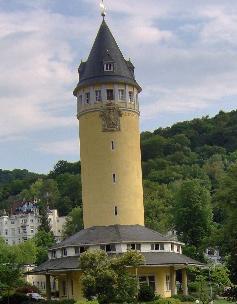Bad Ems
Bad Ems (German pronunciation: [baːt ˈʔɛms] ⓘ) is a town in Rhineland-Palatinate, Germany. It is the administrative seat of the Rhein-Lahn rural district and is well known as a spa on the river Lahn. Bad Ems was the seat of Bad Ems collective municipality, which has been merged into the Bad Ems-Nassau collective municipality. The town has around 9,000 inhabitants. In 2021, the town became part of the transnational UNESCO World Heritage Site under the name "Great Spa Towns of Europe", because of its famous hot springs and 18-20th century architecture bearing testimony to the popularity of spa resorts in Europe during that time.[3][4] GeographyThe town is located on both banks of the River Lahn, the natural border between the Taunus and the Westerwald, two parts of the Rhenish Slate Mountains. The town and its outer districts are situated within the Nassau Nature Reserve. History In Roman times, a castrum was built at Bad Ems as part of the Upper Germanic Limes, but today not much of the structure remains. In the woods around the town, however, there are distinct traces of the former Roman border. The town was first mentioned in official documents in 880 and received its town charter in 1324. The Counts of Nassau and Katzenelnbogen rebuilt the bath and used it together with other noble visitors.[5] In the 17th and 18th centuries Bad Ems was considered one of Germany's most famous bathing resorts. It reached its heyday in the 19th century when it welcomed visitors from all over the world and became the summer residence of various European monarchs and artists, including Kaiser Wilhelm I of Germany, Tsars Nicholas I and Alexander II of Russia, Richard Wagner, Fyodor Dostoevsky and Vasili Vasilyevich Vereshchagin, etc. In 1870, the town, then part of Prussian Hesse-Nassau, became known as the place where the Ems Dispatch originated, instigating the Franco-Prussian War. In 1876, in the Haus Vier Türme (Four Tower House), the Ems Edict was signed by Alexander II of Russia, banning the use of the Ukrainian language. Today, a monument at the spot commemorates this historical event.  MiningIn the 19th and 20th centuries a lot of mining for metal ores took place in the town, concentrated on lead, silver, zinc and copper. The Romans had already dug for ores using open cast mining, which continued throughout the Middle Ages. The many indentations on Blöskopf Hill bear witness to this period of history. As time went by, the method changed from open cast mining to underground mining with tunnels and shafts. Mining of this kind is first mentioned in a document dated 1158, and it continued on into the 18th century, although with long interruptions. The advent of the Industrial Revolution led to the expansion of the mine, which from 1871 operated under the name of Emser Blei- und Silberwerk AG (Bad Ems Lead and Silver Works, Inc.). In 1909 the company was taken over by what later became the Stolberger Zink AG (Stolberg Zinc Inc.) and mining continued until the end of the Second World War brought things to a halt in 1945. After the war, the mine no longer received any subsidies, but until 1959, stockpiled ore and ore from other mines were sorted at the central preparation plant in Silberau. Today, the mine is still known as "Mercur", the collective name for various individual pits. Since 1996, the mine has been set up as a museum. EconomyIndustry in Bad Ems is mainly limited to companies related to its spa status, but nonetheless fairly varied, including medicine, electrical engineering and tourism. Mineral springsBad Ems is located on a cluster of mineral hot springs. These springs are high in sodium bicarbonate and have temperatures between 27 and 57 °C (81 and 135 °F).[6] They originate from groundwater infiltration from the Rhenish Lower Devonian formation.[6] Natural Ems salt is produced from this mineral water, and it is also marketed separately for drinking and inhalation purposes; when inhaled using a vaporizer, the water has a beneficial effect on sore throats.[7] InfrastructureTransportBad Ems is served by Bad Ems station, which is on the Lahntal railway. Slow trains also serve Bad Ems West halt. The town is linked to a view point at the Bismarckturm (Bismarck tower) by the Kurwaldbahn funicular railway. Another (discontinued) form of transport is the Malbergbahn (opposite to the Kurwaldbahn). Gallery
Notable people Sons and daughters
Personalities associated
GovernanceMayorThe Bürgermeister (mayor) of Bad Ems is Oliver Krügel (CDU).[1] Town twinningBad Ems is twinned with:
Notes
References
External links
|
||||||||||||||||||||||||||||||||||||||||||||||||||||||||||||||||






















